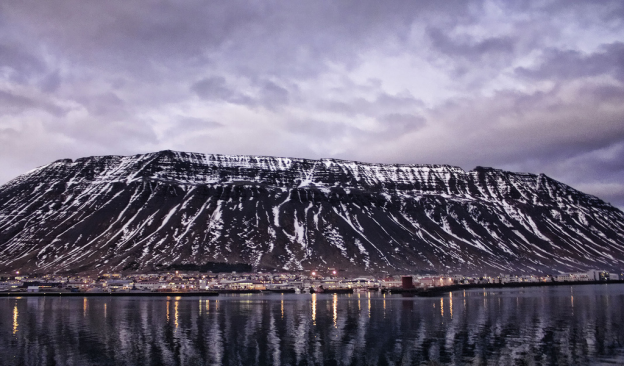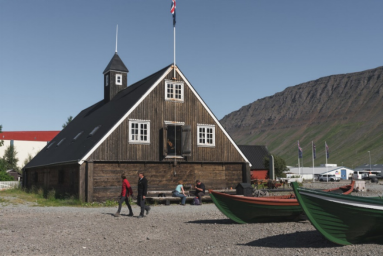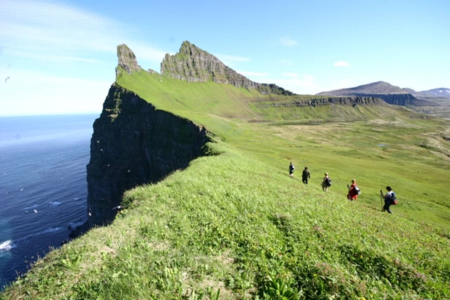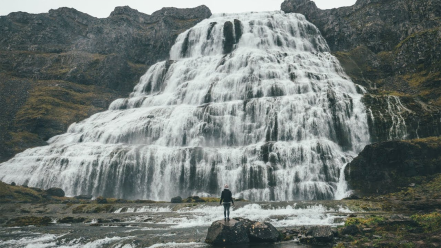Ísafjarðarbær 作者: 来源: 发布时间:2021-09-30
一、所属省或是州,具体位置,人口,面积
Ísafjarðarbær is a municipality of Iceland in the Westfjords region, created in 1996 from Flateyrarhreppur, Ísafjarðarkaupstaður, Mosvallahreppur, Mýrahreppur, Suðureyrarhreppur and Þingeyrarhreppur. The principal settlement is Ísafjörður, others being Hnífsdalur, Flateyri, Suðureyri and Þingeyri. The municipality is Iceland’s 15th largest by area, and Iceland’s 15th largest by population, with a total area of 2,397.3 square kilometers and a population of 3,809.

二、自然地理
1.地理条件
Ísafjarðarbær consists of many settlements. The municipality came into being when a major merger of municipalities in the northern Westfjords took place in 1996. Then Þingeyri, Mýrahreppur, Mosvallahreppur, Flateyri, Suðureyri and Ísafjörður merged under the name Ísafjarðarbær. There are five settlements in the municipality: Ísafjörður, Hnífsdalur, Suðureyri, Flateyri and Þingeyri. The population of the municipality is over 3,500. Most all services are available in the municipality, but the main service core is located in Ísafjörður.
Ísafjörður is located on Skutulsfjörður, a branch of Ísafjarðardjúp, framed by the steep mountain slopes of Eyrarfjall (up to 731 m) and Kirkjubólsfjall (up to 832 m) . The city forms the economic and administrative center of the Westfjords.
The sandbar (isl. Eyri) that supports the place has been raised again and again to create new territory. Thus the area of the city has continuously increased, the peninsula now almost stretches from one bank of the fjord to the other, creating an effectively protected harbor.
Suðureyri is located on the south coast of Súgandafjörður. There is a hot spring nearby, the water of which is used for heating. On the north coast of the fjord, north of the village, the mountain Góltur rises up. To the south is the mountain Ufsir.
https://www.westfjords.is/is/westfjords/town/isafjardarbaer
2.交通情况
From June to August there are boat connections from Ísafjörður to the almost completely deserted and difficult to reach Hornstrandir peninsula (nature reserve) on the other side of Ísafjarðardjúp. For several years now, cruise ships have been docking in the port between May and early September. A total of almost fifty calls are planned for 2020, including the German-speaking providers AIDA, Phoenix Reisen and TUI Cruises.
The transport and supply-related importance of the place becomes particularly clear through the connection to the domestic Icelandic flight network; the airfield of Isafjordur is located on the city opposite shore of the fjord.
The distance to the capital Reykjavík is 457 kilometers by road; the nearest town, Bolungarvík, is about 15 kilometers to the northwest.
三、经济发展和规模
Ísafjarðarbær 's annual accounts are prepared in accordance with local government legislation, 4 annual accounts, accounting regulations and annual accounts of municipalities and advertisements by the Ministry of Welfare on municipal accounts.
The municipality's operating income for the 4th year amounted to ISK 5,324 million according to the consolidated income statement for A and Part B, but the budget estimated operating income at ISK 5,315 million. The operating income of Part A amounted to ISK 4,544 million, but the budget estimated operating income at ISK 4,539 million.
The tax rate was 14.52%, which is a minimum wage. The real estate tax rate was 0.625%
for Ibudahusnedis and 1.65% for atvinnuhusnedis, logbundid is 0.5% and 1.32% but the municipality is allowed toincrease the alignment by 25%.
The operating results of the municipality according to the consolidated income statement of parts A and B were approved by 238 million ISK, but according to the budget, a surplus of about ISK 83 million was made. The operating results of Part A were positive about ISK 14 million, but the budget estimate was R40 for a deficit of about ISK 97 million. The municipality's equity at the end of the year ISK 1,870 million according to the balance sheet, while the equity of Part A amounted to ISK 1,127 million.
Wages and salary-related expenses of the municipality and institutions amounted to ISK 2,643 million, while the number of employees of the municipality was 312 full-time equivalents at the end of the year.
https://www.isafjordur.is/is/stjornsysla/fjarmal/arsreikningar
四、产业特点重点项目
Ísafjörður was once the largest shrimp fishing site in Iceland and is still famous for its fishing. The largest industries in the municipality are the fishing industry, tourism and other service jobs. Major employers in the region include Hraðfrystihúsið-Gunnvör, 3X technology, Klofningur, and Íslandssaga. Ísafjörður is also the base of several noteworthy start-up companies including Fossadalur and Kerecis.
Ísafjörður is the home to the University Centre of the Westfjords. The University Centre offers three master's degree programs. One in Coastal & Marine Management, one in Coastal Communities and Regional Development and another in Marine Innovation. Students graduate from the University of Akureyri.
A severe decline in the fishing industry for a variety of reasons, such as fishing restrictions in the early 1980s, and a decline in the fish population, has led the inhabitants to seek work elsewhere, leading to a decline in the town's population. The harbor also serves ferries to nearby settlements as well as larger cruise ships for tourists visiting the area. The tourist industry is growing; it is a major access point to the nature reserve on the Hornstrandir Peninsula, an uninhabited wilderness area to which ferries run weekly during summer.
The people of Flateyri still live mainly from fishing. Since this has become less and less profitable, quite a few commute through the tunnel to Ísafjörður to work.
In Flateyri there is a kindergarten and a comprehensive school as well as medical care, gas station, restaurant, guest house and sports facilities with a swimming pool.
五、风景名胜,景点( attractions)
1. Byggðasafn Vestfjarðar (Westfjord Regional Museum)

The first ideas for a maritime and regional museum for the Westfjords were presented by Bárður G. Tómasson, a naval engineer, in a newspaper article he wrote for the newspaper Vesturland in December 1939. He called his article "Sexæringar". There he made a recommendation to the people of Ísfirðir that they unite to have a six-storey building built with an old track and all the trash. Bárður's idea was that the six-year-old would be the first indicator of the district and maritime museum of the area. He urged people to support this issue with financial contributions. The idea was well received and Jóhann Bjarnason, a boat builder in Ísafjörður and former chairman in Bolungavík, was hired to build the six-seater. It was ready in the summer of 1941 and was named Ölver.
On July 23, 1941, the Ísfirðingar Regional and Maritime Museum was founded and Bárður G. Tómasson was elected its first chairman. At the meeting, he handed over the six-year-old to the museum and presented a report on the cost of its construction and fundraising. With the construction of the six-ring, it can be said that the foundation was laid for the regional museum's maritime museum, which was opened in Turnhúsið in Neðstakaupstaður on the fishermen's day in 1988. When the tent in Ósvör in Bolungarvík was built.
Sögufélag Ísfirðinga was founded in 1953 and was one of the goals of promoting the growth and development of the regional museum, but its activities ceased to a large extent after 1946 as its leaders were either moved or moved to other localities. In 1953, the board of the History Society presented the idea of reviving and expanding the museum's operations. The Act on the Maintenance of Ancient Structures and Regional Museums of 1947 contained provisions to the effect that regional museums were entitled to a grant from the State Treasury for the establishment and operation if a district or districts decided to establish a museum, provided that ancient buildings were preserved in those areas. considered to be such a museum archive in the opinion of the National Guard. The town council of Ísafjörður and the county committees of Norður- and Vestur-Ísafjarðarsýslna decided to become joint owners and operators of the museum. The name Byggðasafn Vestfjarði was given at the request of Vestfirðingafélag in Reykjavík. At the beginning of 1975, the town of Bolungarvík became a member of the museum. The first chairman of the board of the Westfjords Regional Museum was elected Jóhann Gunnar Ólafsson, district commissioner and town sheriff.
https://www.nedsti.is/frettir_og_tilkynningar/
2. Hornstrandir Nature Reserve

This territory of the Arctic fox has been uninhabited since the 1950s. As isolated as it was then, it attracts the casual half-day visitors and serious gore-tex hikers alike. Its main attractions are three. First, the bird cliffs surrounding the bay of Hornvík, are a magnet of gigantic proportions. On the eastern side of the bay the cliff reaches a height of more than 500 metres, and the birds are teeming. Second, as there is no infrastructure and the tourists few in relation to the sheer size of the area, the sense of remoteness is strong. You can hike days on end without seeing a single person. The nature is pure and the tranquillity unmatched. Third, dwas the area is a haven for the Arctic fox (think hunting-ban and bird-packed cliffs), the chances of spotting one are high.
Most tours, especially day tours, depart from Ísafjörður. Hikers wanting to go on their own can also take boats from Norðurfjörður.
https://www.westfjords.is/en/what-to-see-and-do/places/nature/hornstrandir
3. Dynjandi waterfall

Dynjandi, or Fjallfoss as it is often called, cascades some 99-100 meters, looking exactly like a beautiful bridal veil. On top, it is 30 meters wide and widens up to 60 meters at the bottom.
There are 6 other waterfalls below Dynjandi, which one passes on the way up to the biggest waterfall. It is quite a scenic route with an elevation of some 200 meters up to the biggest waterfall.
To reach Dynjandi there is a bit of a hike, no more than 15 minutes or so though, and on the way up you can stop by all the smaller waterfalls. A rocky path, made by volunteers back in 1996, leads up to the waterfalls and it is a bit of a climb getting all the way up to Dynjandi.
https://guidetoiceland.is/connect-with-locals/regina/dynjandi-the-jewel-of-the-westfjords
六、历史文化
1.历史
The first settler in Landnámabók is Helgi Hrólfsson , who came to this place around 920 and gave the fjord Skutulsfjörður its name when he found a harpoon (isl. Skutull ) on the beach at this point .
In the 16th century, German and English companies established their trading branches here. The houses built during the Danish trade monopoly on the southern tip of the peninsula now form the Neðstikaupstaður local history museum. They represent the oldest surviving settlement core in Iceland (Krambúð - 1757; Faktorhús - 1765; Tjöruhúsið - 1781; Turnhúsið - 1784).
Ísafjörður's general prosperity only came with clipfish processing in the 18th century.
1787 was Isafjordur to trading center, in 1866 the town was granted the town charter.
Þingeyri is the oldest trading post in Vestur-Ísafjarðarsýsla. The warehouse from 1733 is one of the oldest Icelandic buildings. In 1996 the municipality was united with five other municipalities to form Ísafjarðarbær.
2. 文化体育
There is a music school in Ísafjörður. Opposite the new hospital, the former hospital now houses a cultural center with a library and exhibition rooms. In the Aðalstræti (Eng. "Main Street") is the Slunkariki art gallery, where works by international and Icelandic artists are shown. Also worth seeing is the idiosyncratic, ocher-colored concrete church (completed in 1995) and the adjoining cemetery. Located at the eastern mouth of the Skutulsfjörður, the red and yellow lighthouse Arnarnesviti is only about five meters high and was built in 1902.
The town Ísafjörður hosts varied and widely popular events, in the realms of both culture and outdoor recreation. These events include, but are not limited to:
The Ski Week Festival
Aldrei fór ég suður music festival
Fossavatn Ski Marathon
European Swampsoccer Championships
Act Alone – a theatre festival dedicated to the art of acting alone, monodrama, held in August every year
Westfjords Heritage Museum
七、其他信息
The winter of 1995 turned out to be particularly snowy. This resulted in some serious avalanche accidents in Iceland. On October 26, 1995, a large avalanche broke out from Eyrarfjall above Flateyri. 45 people were buried under her, 25 of whom were rescued in difficult circumstances, but 20 died. Numerous houses were destroyed. A documentary by Einar Þór Gunnlaugsson from 2010 about the events and the rescue operation also mentions that because of the difficult weather conditions and transport links - there was no connection to Ísafjörður through a tunnel yet - the people in Flateyri initially 5 Left on their own for hours.
Avalanche barriers are now supposed to divert further avalanches from the village. There is a viewing platform on the barriers.
八、联系方式

Mayor: Birgir Gunnarsson
Telephone: 450 8000
Email: birgir@isafjordur.is
https://www.isafjordur.is/is/stjornsysla/baejarstjorn/baejarstjori
